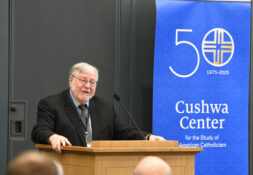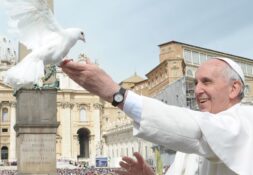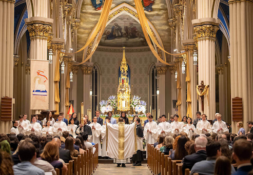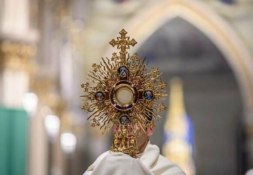On the meaning and history of veiling at Mass
Occasionally at Mass, one may see a woman with a lace veil or some other type covering on her head. To some, veiling is a familiar, albeit old-fashioned custom. For most young Catholics, however, this is something they have rarely seen. And yet, it has been common practice for millennia for Catholic women to wear lace veils or headscarves at Mass. With that in mind, what is the significance of this tradition, and in what manner should it be continued today?
The practice of women covering their heads at Mass and in the presence of the Blessed Sacrament has roots in Scripture. Most familiar is St. Paul’s discussion in 1 Corinthians 11:4-5: “Any man who prays or prophesies with his head covered brings shame upon his head. But any woman who prays or prophesies with her head unveiled brings shame upon her head, for it is one and the same thing as if she had had her head shaved.”
St. Paul’s injunction is sometimes dismissed as something specific to his time and place, and thus with no bearing on our devotional practices today. The meaning of veiling, however, is not a matter of diminishing women’s standing but a timeless liturgical means of honoring both women and God.
The Church routinely uses the image of a husband and wife to understand the relationship between Christ and the Church. Like a husband, Christ loves and cherishes His Church, and in return, the whole body of the Church is to honor and submit to Christ, the head of the Church. Thus, every woman is understood to be an image of the Church. The act of veiling at Mass is a symbol of humbling oneself, a reminder to the whole Church that we are to submit ourselves to the will of God in all our affairs.
In fact, there are a great many things within a church itself that are veiled, reminding us of this tradition. The tabernacle itself is veiled. The altar, too, is veiled with layers of linen. The priest veils himself in many different vestments. The chalice, though not as often in modern times, is covered with a chalice veil. And all of the faithful “veil their faces to the Presence” as Ralph Vaughan Williams states in his famous “Let All Mortal Flesh Keep Silence” when incense fills the sanctuary.
Both liturgy and Scripture indicate that the act of veiling is a sign of the sacred. Throughout the Old Testament, sites of God’s presence like the Ark of the Covenant or the Holy of Holies are surrounded by a veil or curtain to shield the people from that holiness. The veil was put in place to protect them from a dangerous good. This is also the proper conception of how veiling corresponds to modesty: It covers a good thing (the beauty of a woman) to avoid the relative danger of distraction at Mass. Thus, veiling is meant to direct our attention to God and glorify Him, the focus of our liturgical worship. Women veil out of reverence for Jesus Christ, truly present in the Eucharist.
Veiling was a universal practice of the early Church, as attested by catacomb paintings of veiled women praying. Several Church Fathers also wrote on the subject, including Clement of Alexandria. In Paedagogus, he writes, “Let her be entirely covered, unless she happen to be at home. For that style of dress is grave, and protects from being gazed at… nor will she invite another to fall into sin by uncovering her face. For this is the wish of the Word, since it is becoming for her to pray veiled.” The context of this passage is specifically for dress in church, but Clement does argue for veiling for the sake of modesty rather than worship.
There was some disagreement even at this time over what modesty demands. Tertullian wrote a tract entitled On the Veiling of Virgins to encourage virgins to veil, in addition to married women. He notes, “throughout Greece, and certain of its barbaric provinces, the majority of Churches keep their virgins covered,” but that virgins are unveiled more commonly in Africa. Tertullian argues that modesty demands virgins should veil as well, but it is important to note that the standards of modesty had some variance even in the early Church.
Though particular styles and standards of modesty changed through the centuries, the practice of veiling continued uninterrupted until modern times. The practice was universally assumed when the 1917 Code of Canon Law stated that women should cover their heads “in a church or while assisting with the sacred rites outside of a church…especially when they approach the Lord’s Table.”
Around the 1960s, some women began to cast aside the veil, rejecting it a symbol of oppression rather than respect for their distinct dignity as women. Following a misunderstanding from a news conference in 1969 and broader cultural change, women no longer thought they were required to or should veil. Virtually all women in the United States stopped the practice of veiling. Due to this, when the 1983 Code of Canon Law was issued, the question of women’s veiling was not mentioned. Thus, as it stands now, the practice is neither explicitly prescribed nor proscribed. Women are free to practice this tradition, but are not obligated to do so.
For most women, however, the question of to veil or not to veil is not a matter of canon law or historical precedent, but an individual devotional practice. Because veiling is inherently public, however, it can be an intimidating prospect to try for the first time. One may be reluctant to stand out or appear “holier-than-thou.” Of course, these are not the reasons for veiling, nor are they in keeping with the intentions for veiling: reverence, humility, and modesty.
There is a concrete solution to this practical dilemma: If you are afraid to veil because you’ll stand out, try veiling anyways as an opportunity to mortify your vanity and to honor our Eucharistic Lord. As we enter this penitential season of Advent, we challenge you to veil this Sunday, December 8, the Feast of the Immaculate Conception. It is a perfect opportunity to become more comfortable with a practice that has a rich and venerable history within the Church.
This article was brought to you by the Theology Club’s Zossima Project: Making Prayer an Education. For a complete works cited, please email zossimaprojectnd@gmail.com. Thank you for your readership.






Leave a Reply